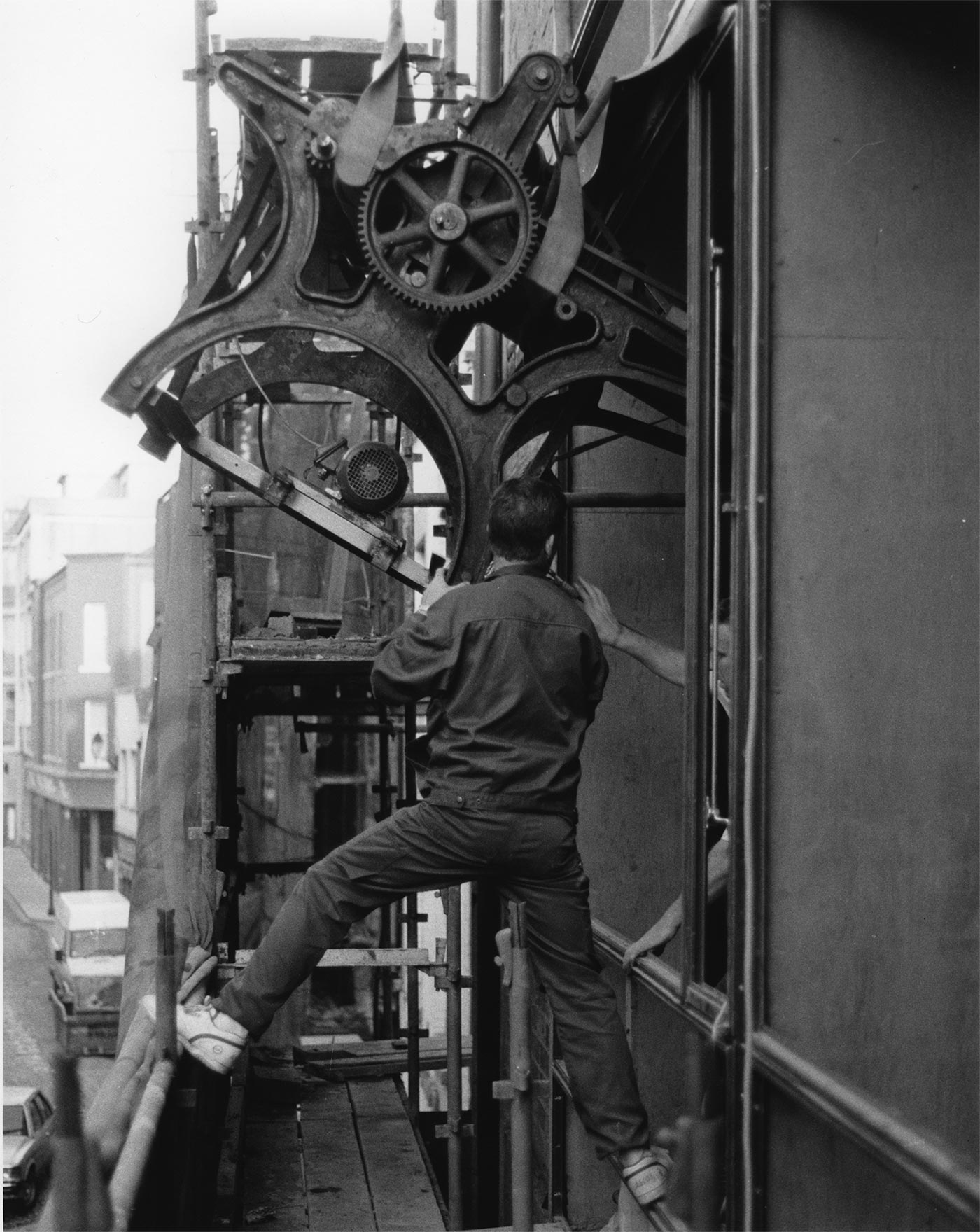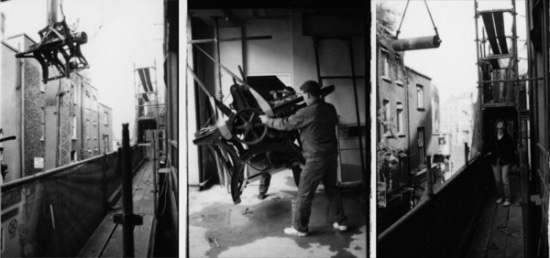History
Written by Sara Horgan
Founder Member of Black Church Print Studio
Black Church Print Studio first opened for business on 1 October 1982 but the very first committee meeting had been two years before that on 1 January 1980, in my kitchen. The initial Board of Directors was appointed, Liam Ó Broin, Michael Byrne, Pádraig O Cuimín and Phoebe Donovan, who was backing a new enterprise at almost 80 years of age, with myself, Sara Horgan as Secretary and John Kelly as the first rotating Chairman.The only print studio in the country at that time was Graphic Studio Dublin, established 20 years earlier.It was located in a rather dank basement in Upper Mount Street. Patrick Hickey was the Director for the first ten years, John Kelly for another ten and Leslie Mac Weeney, whom I later succeeded, was Secretary.The Arts Council was aware of developments in France and the United States that were reviving the arcane world of printmaking, and in 1977, under the Directorship of Colm Ó Briain, approached Graphic Studio Dublin with a suggestion of expansion. Apart from the cramped and oversubscribed conditions in Upper Mount Street, this expansion was necessary because the National College of Art and Design was undergoing major changes and was about to start awarding diplomas and later degrees in printmaking. Graphic Studio Dublin,as the only existing public printmaking facility in Ireland, would shortly become inadequate.

We set ourselves up as a Company Limited by Guarantee under the name Black Church Print Studio.We submitted conversion plans for the Black Church to the Arts Council, who agreed to give us £80,000, which was a lot of money at the time. However, as the Dublin saying goes,‘Three times around the Black Church and you meet the devil’. As we had concerns about the plaster in the Black Church, we had it analysed and found that it was a double layer of disintegrating asbestos. To remove it would add £40,500 to the cost,which we were unwilling to bear.We started house-hunting again. One of the best options,which came through Pádraig O Cuimín, architect in CIE,was in the area that CIE was reserving for a transport centre in Temple Bar. This was a magnificent ex-clothing factory, too big for our needs.We approached the Arts Council with the idea of them taking on the building and running it as a multiple tenancy of arts organisations –this was already happening in the London docklands and in Scotland. The factory eventually became the Temple Bar Gallery and Studios, under brave Jenny Haughton.We kept the name Black Church Print Studio in the firm hope of the eventual resolution of our housing situation but without working facilities we risked losing all momentum. However, within a short time we rented a unit temporarily at Ardee House at the top of the Coombe. Loughlin Kealy, later Professor of Architecture in University College Dublin, advised us on the initial layout.We settled in, ordering and installing new and second-hand equipment, and establishing workshop practice.


Black Church Print Studio finally opened in October 1982 with a positive ethos: entry was by invitation or portfolio. At least a token payment for all services rendered was given; one print from every edition was to be donated to the Studio. There was an encouraging studio atmosphere and an open welcome. Learners’ access was by a strict progression from beginner, to working under supervision and to possibly evolving intoa full member and key holder. Experienced printmakers joined, Gráinne Cuffe was the first, followed by Jackie Stanley.We offered beginner printmaking courses in January 1983 and by that September we ran an intensive week to attract artists.We had an excellent line-up:Cecily Brennan, Eithne Jordan, James McCreary, Aileen McKeogh, Theo McNab, Michael O’Sullivan, Rob Smith and Oliver Whelan. By late 1983, Andrew Folan had replaced Liam Ó Broin as a Director on the Board and brought his darkroom experience to the Studio.That same year Graphic Studio Dublin left their Upper Mount Street premises and moved to Green Street East.They also opened a Print Gallery in the Powerscourt Town House on South William Street. Nevertheless,the Arts Council was still pressing for the idea of anational print centre and together both studios looked at a number of alternative buildings for sale.In 1984 the first Black Church Print Studio exhibition was held in the Triskel Art Centre in Cork. The first in Dublin was over Ray’s Restaurant on Crow Street, which travelled to Longford. Our artistic profile was beginning to increase, Gráinne Cuffe was awarded a scholarship to the Tamarind Institute in New Mexico and the Arts Council organised VIP representatives to visit from print societies and museums in Cleveland and Sweden.The first Studio scholarship was awarded to Christy McGinn.We published Ireland’s first commissioned fine art lithograph, Barrie Cooke’s Megaceros Hibernicus (Great Irish Elk), and later we printed a cover illustration by Barrie for a John Montague poetry collection.
In 1985 the Arts Council, under the new Directorship of Adrian Munnelly, announced that they had agreed with Dublin Corporation to share the cost of the asbestos removal in the Black Church and suggested that the two studios regroup. It was too late.We found ourselves in an enforced marriage of the two Studios, which entailed shared Arts Council budget applications. This system was to be eventually annulled in 1989, ten years after the split. Nonetheless, our members were making their mark in Studio and other exhibitions, Gráinne Dowling won a Salmon poetry magazine award, Andy Folan won the Douglas Hyde Gold Medal for Print at the Oireachtas, Marie Louise Martin won a Print Award at the RHA, as I did in the last Bradford Biennale. We became much more ambitious in 1986 when John Kelly suggested we stage a First Irish Mini print exhibition. It was held at the Hendriks Gallery on St Stephen’s Green, with 326 prints on show. This exhibition was sponsored by We Frame It and short-listed for a Sunday Tribune Arts Award. Links continued with Graphic Studio Dublin over the following years. Still on a joint Arts Council budget,Marie Louise Martin and I were asked to view the site of what was to become the Graphic Studio Dublin’s new gallery off Cope Street. In 1987, to coincide with a celebration of Irish women artists in the National Gallery and the Hugh Lane Municipal Gallery, Graphic Studio Dublin gallery at Powerscourt mounted an exhibition of Irish women printmakers: Maria Simmonds Gooding, Alice Hanratty, Jenny Lane, Mary Farl Powers, AnneMadden and me.The Douglas Hyde Gallery organised educational tours to the Studio and Art History students visited from the National College of Art and Design. The second Irish Miniprint exhibition followed, administered by Mary Bryans and jointly sponsored by the Rohan Group and We Frame It. Held in the RHA Gallery in 1987 and including 541 entries from 22 countries, it was numerically bigger than Living Art, Oireachtas and Rosc exhibitions combined. The show toured Kilkenny, Limerick and Cork and brought in excellent sales and publicity for print and for the Studio. The first British Miniprint exhibition followed, organised by Peter Ford,the winner of the First Prize at our exhibition.After Michael Byrne’s death in 1988, John Kelly,Dan Treston (Michael’s life partner), and I set up an exhibition in the Davis Gallery and announced the Michael Byrne Scholarship for Printmakers, the first of which was awarded to Michael Corcoran. After Dan died,I handed over this scholarship to the Arts Council to administer.By September of 1990, our Committee was Barbara Dunne, Andy Folan, Jan de Fouw, Marie Louise Martin, Jackie Stanley and me. A total of 79 artists had used our Studio. We had organised a total of 22 Studio exhibitions and had a further 8 in the pipeline.We were starting to prepare the European Large Format Printmaking exhibition.We were also lining up a Studio exhibition in The Hague for the next year and another in the Riverrun Gallery Dublin. The ILAC Library had asked for a small exhibition and Jan de Fouw was organising a Studio calendar to benefit the Rape Crisis Centre. We were in negotiations with our landlord about moving the screen-print area into a second unit at a reduced rate. Then we had a break-in by kids (judging by the footprints) who got the petty cash box. The window was reset with fresh iron bars, but a week later they got in again. This time, not finding the petty cash, they set fire to the Studio. The ensuing fire was compounded by explosions of inks and solvents and much was lost by fire or water damage, including the Studio’s records.



Everyone rallied around, our members, friends and several members of Graphic Studio Dublin.We dismantled presses, shifting what could be salvaged,and gave Graphic Studio Dublin the ball-grainer we had got from the Ordnance Survey. Members claimed back what was left of their work and gear. Everything was put into storage. It was back to the kitchen table for Board meetings, with the charred filing cabinet in the living room. A formal meeting for all the Studio members followed at the Artists Association of Ireland office in Liberty Hall, chaired by Jan de Fouw. The members voted overwhelmingly for the Studio to continue,encouraged by our insurance loss adjuster’s hard work,which provided the seed money to carry on. Our show at Riverrun Gallery Dublin became a Phoenix Exhibition to publicise our crisis and we took a collection in a fireman’s helmet.Andy undertook to administer the European Large Format Printmaking exhibition in the Guinness Hopstore and negotiated printing facilities for Studio members in the National College of Art and Design for the summer.I set up viewings of yet more premises from an armchair after a car crash. After some false starts with other premises, such as Marrowbone Lane, Cornmarket and Broadstone, I was finally able to enter negotiations with Temple Bar Properties Ltd and we were accepted as clients by them on the evening of the Large Format Printmaking exhibition opening.We held a viewing in the RHA Gallery for Studio members, of McCullough Mulvin’s architectural proposal for the new studio beside their scheme for Temple Bar Gallery and Studios.We had come full circle.Once the Temple Bar Properties Ltd submission arrived at a financial package and planning permission for a purpose-built studio and gallery, I resigned, burnt out and thanks to an aunt’s legacy left for Samarkand, and later Timbuctoo. The aspiration of a national print centre never materialised, but the aims of regular and travelling exhibitions,active marketing, editioning, galleries, screen-printing and darkroom, were all achieved over time.Through our Studio shows, we made print and the Studio better known in both national and international contexts and more particularly, in generating the two Irish Miniprint and Large Format Printmaking exhibitions we surpassed our original aims. Also, we wholeheartedly played a part in advising the growing network of printstudios in Ireland.All that time and effort spent in house-hunting was validated by the eventual resolution, a new purpose-built printmaking studio right in the middle of Temple Bar: and the legacy continues.


Today the Studio provides professional facilities for artists working in a range of print media together with full technical and administrative support. The Studio currently has 85 full-time artist members working in screen-printing, intaglio methods, lithography, relief printing and digital printmaking.
The Studio also offers temporary and assisted access, education and outreach, international artist-in-residency and an exhibition programme. Since its opening the Studio has established itself as a significant and dynamic organisation and has proved to be a valuable facility and resource for hundreds of artists over the years and is now one of the leading contemporary fine art print studios in Ireland.
It promotes the study and understanding of traditional and new methods of printmaking and maintains a permanent centre where printmaking was taught, practiced and encouraged.
The Studio has orgainised many exhibitions in Ireland and promotes the awareness of international printmaking by participating in exchange exhibitions.
It is grant-aided by the Arts Council, Dublin City Council and the Department of Culture, Heritage, and the Gaeltacht.


